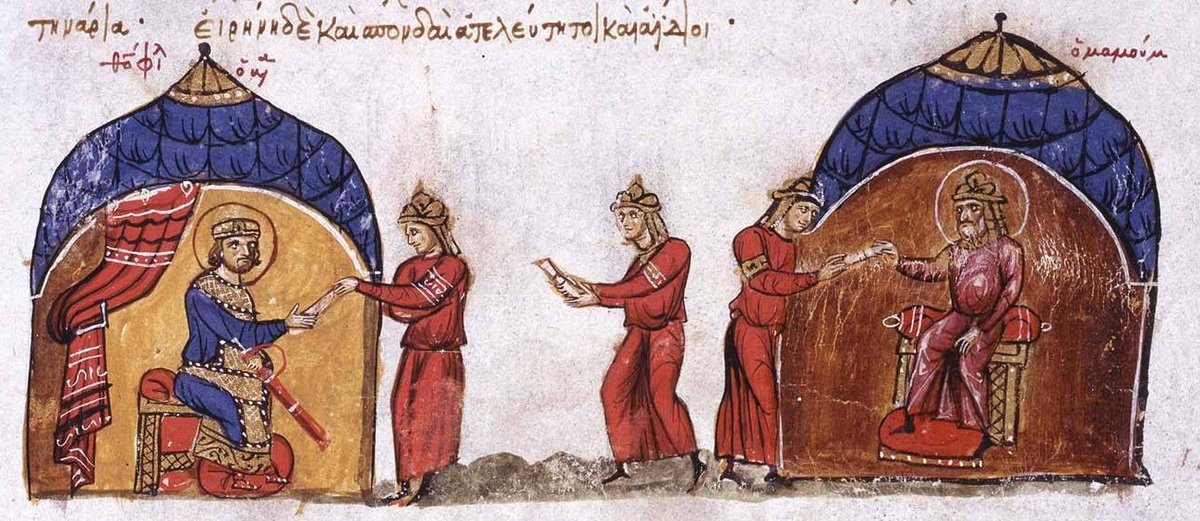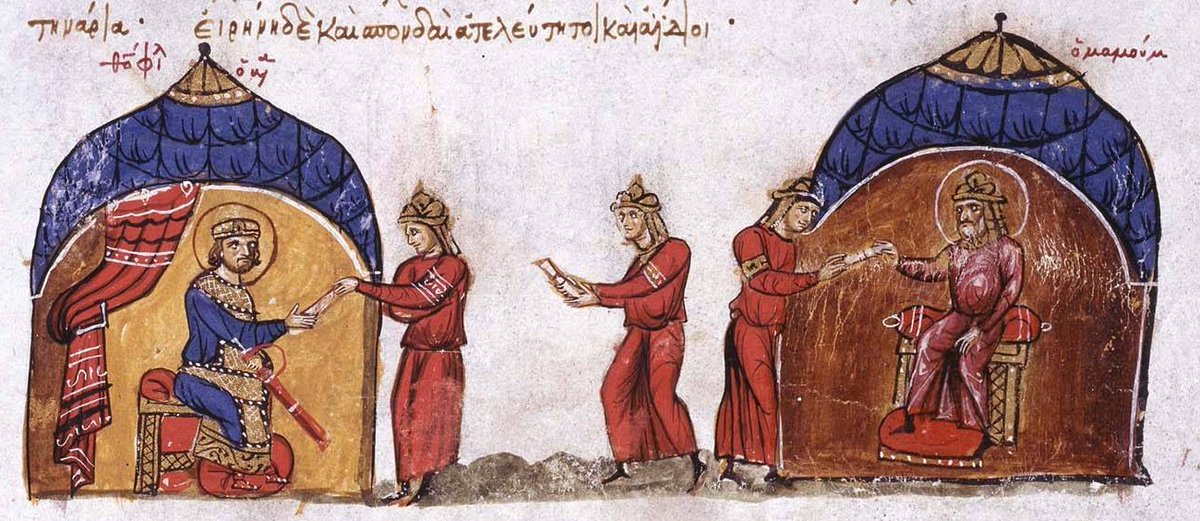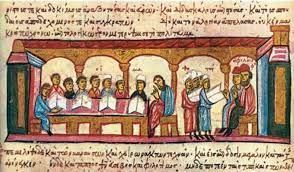Thread 🧵on Leo the Mathematician
Leo the Mathematician or Philosopher (Λέων ὁ Μαθηματικός ή Φιλόσοφος) was a distinguished Greek/Armenian scholar who associated himself with the Macedonian Renaissance (Μακεδονική Αναγέννηση).
Hope on for a travel back in time!
(1/14)
Leo the Mathematician or Philosopher (Λέων ὁ Μαθηματικός ή Φιλόσοφος) was a distinguished Greek/Armenian scholar who associated himself with the Macedonian Renaissance (Μακεδονική Αναγέννηση).
Hope on for a travel back in time!
(1/14)

Leo was a cousin of John Grammaticus (Ιωάννης Ζ΄ Γραμματικός) - the Ecumenical Patriarch of Constantinople between 837 and 843 AD.
The patriarch originated from the Armenian noble house of the Muratsan (or Maratswots) and this explains Leo's partly Armenian ancestry.
(2/14)
The patriarch originated from the Armenian noble house of the Muratsan (or Maratswots) and this explains Leo's partly Armenian ancestry.
(2/14)

Leo as a youngster was invited by the patriarch in Constantinople for studies.
Oddly enough, he opted for a secular curriculum in the "Γραικών γράμματα" ("letters of the Greeks"): Poetry, Rhetoric, Philosophy etc.
However, he never completed his studies in the "City".
(3/14)
Oddly enough, he opted for a secular curriculum in the "Γραικών γράμματα" ("letters of the Greeks"): Poetry, Rhetoric, Philosophy etc.
However, he never completed his studies in the "City".
(3/14)

Instead, he decided to retreat to a monastery in Andros Island where he was taught Physics and Mathematics by a monk.
This story dispels the well-established notion that the Arabs saved the Letters and Sciences of Ancient Greeks and transmitted them to Europe via Spain.
(4/14)
This story dispels the well-established notion that the Arabs saved the Letters and Sciences of Ancient Greeks and transmitted them to Europe via Spain.
(4/14)

After this odd cycle of studies, he returned to Constantinople where he taught (in private) next to the Monastery of Stoudios.
One day in 831, one of his students - an officer in the Imperial Army - was captured during a disastrous war against the Abbasid Caliphate.
(5/14)
One day in 831, one of his students - an officer in the Imperial Army - was captured during a disastrous war against the Abbasid Caliphate.
(5/14)

The captive impressed the commander in Mosul with his deep knowledge and was duly dispatched to Caliph Al Mamun (a ruler known for his love for Scholarship) in Baghdad.
Indeed, the Caliph greatly sponsored the House of Wisdom (Bayt al-Ḥikmah) in Bagdad during his reign.
(6/14)

Indeed, the Caliph greatly sponsored the House of Wisdom (Bayt al-Ḥikmah) in Bagdad during his reign.
(6/14)


The Caliph was equally impressed by the captive's knowledge of Astronomy and Mathematics and asked for his teacher's identity.
The latter revealed that Leo was his tutor.
The Caliph instantly penned a letter for Emperor Theopilos and ordered the prisoner to deliver it.
(7/14)
The latter revealed that Leo was his tutor.
The Caliph instantly penned a letter for Emperor Theopilos and ordered the prisoner to deliver it.
(7/14)

The Caliph promised the Emperor a "perpetual peace" under one condition: the temporary service of Leo in Baghdad.
The Emperor was shocked to discover that a teacher at a stone's throw from the Imperial Palace was a "celebrity".
He decided to not sacrifice Leo.
(8/14)
The Emperor was shocked to discover that a teacher at a stone's throw from the Imperial Palace was a "celebrity".
He decided to not sacrifice Leo.
(8/14)

Instead, he dispatched another scholar with a few (original) texts of Plato and Aristotle for the Caliph-Bookworm and a friendly letter.
The Caliph accepted the gifts but insisted on Leo with a 2nd embassy laden with gold.
Yet, the Emperor refused - again.
(9/14)
The Caliph accepted the gifts but insisted on Leo with a 2nd embassy laden with gold.
Yet, the Emperor refused - again.
(9/14)

The Emperor appointed Leo as a curator in the religious school (ekpaideutērion) in the Church of the Forty Martyrs.
As a testament to the emperor's favor, Leo was consecrated as Metropolitan of Thessoloniki - the 2nd largest metropolis of Romania (Ρωμανία) - in 840.
(10/14)
As a testament to the emperor's favor, Leo was consecrated as Metropolitan of Thessoloniki - the 2nd largest metropolis of Romania (Ρωμανία) - in 840.
(10/14)

However, Leo was evicted from his post after the end of the 2nd Iconoclasm (Εικονομαχία) in 843.
However, he didn't fade into obscurity.
In 855 he was appointed as the curator of the newly-founded Magnaura School - the first university in Europe - by Caesar Bardas.
(11/14)

However, he didn't fade into obscurity.
In 855 he was appointed as the curator of the newly-founded Magnaura School - the first university in Europe - by Caesar Bardas.
(11/14)


The Magnavra (or Πανδιδακτήριο της Μαγναύρας) served as the most important center for learning in Romania.
Cyrillos (Cyril), one of the two apostles of the Slavs, was his student!
Leo endowed the university with a great library with texts from Ancient Greece and Rome.
(11/14)

Cyrillos (Cyril), one of the two apostles of the Slavs, was his student!
Leo endowed the university with a great library with texts from Ancient Greece and Rome.
(11/14)


But Leo wasn't only a scholar. He was an inventor as well!
He was credited with the invention of the system of beacons.
Like the Lord of the Rings, a message (e.g. an enemy raid) could be transmitted from today's South-Eastern Turkey to Constantinople within an hour!
(12/14)
He was credited with the invention of the system of beacons.
Like the Lord of the Rings, a message (e.g. an enemy raid) could be transmitted from today's South-Eastern Turkey to Constantinople within an hour!
(12/14)

Leo, in addition, invented several automata (or primitive robots): trees with moving birds, roaring lions and, most notably, a levitating imperial throne!
The throne was witnessed by Liutprand of Cremona during his visit to Constantinople one century later!
(13/14)
The throne was witnessed by Liutprand of Cremona during his visit to Constantinople one century later!
(13/14)

Leo died in 869 a celebrated man.
Over the years, he wrote scientific treatises, satirical epigrams and even an encyclopedia!
Unfortunately, only a fragment of these works survived.
Still, these fragments attest to a polymath of the Middle Ages!
#Byzantium #History
(14/14)
Over the years, he wrote scientific treatises, satirical epigrams and even an encyclopedia!
Unfortunately, only a fragment of these works survived.
Still, these fragments attest to a polymath of the Middle Ages!
#Byzantium #History
(14/14)

• • •
Missing some Tweet in this thread? You can try to
force a refresh

























